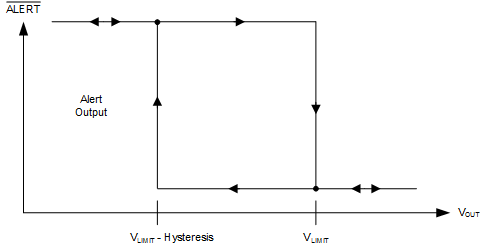ZHCSF49B April 2016 – April 2022 INA301-Q1
PRODUCTION DATA
- 1 特性
- 2 应用
- 3 说明
- 4 Revision History
- 5 Pin Configuration and Functions
- 6 Specifications
- 7 Detailed Description
- 8 Applications and Implementation
- 9 Power Supply Recommendations
- 10Layout
- 11Device and Documentation Support
- 12Mechanical, Packaging, and Orderable Information
7.3.3 Hysteresis
The onboard comparator in the INA301-Q1 reduces the possibility of oscillations in the alert output when the measured signal level is near the overlimit threshold level because of noise. When the output voltage (VOUT) exceeds the voltage developed at the LIMIT pin, the ALERT pin is asserted and pulls low. The output voltage must drop below the LIMIT pin threshold voltage by the gain-dependent hysteresis level for the ALERT pin to deassert and return to the nominal high state (see Figure 7-2).
 Figure 7-2 Typical Comparator Hysteresis
Figure 7-2 Typical Comparator Hysteresis